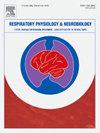慢性高氧诱导幼年和成年大鼠的呼吸可塑性。
IF 1.6
4区 医学
Q3 PHYSIOLOGY
引用次数: 0
摘要
出生后早期发育期间的慢性高氧会抑制新生大鼠的呼吸,并导致低氧通气反应(HVR)的长期衰减。相比之下,对于幼年或成年哺乳动物在生命后期长期暴露于中度高氧环境后对呼吸的控制知之甚少。因此,Sprague-Dawley大鼠暴露于60% O2环境7天(幼鼠)或4天和14天(成年鼠),暴露后立即或在室内空气中恢复较长时间后通过全身容积描记仪测量通气量。高氧处理的幼年大鼠在返回室内空气时出现低通气(与年龄匹配的对照组相比,通气量和二氧化碳对流需求降低11-13%),但慢性高氧不会改变成年大鼠的正常通气量。相比之下,慢性高氧预处理使幼年大鼠(+41%)和成年大鼠(+28-50%)的HVR增加。高氧14天后,成年大鼠的高碳酸血症通气反应(7% CO2)也趋于增强,但考虑到代谢率(即CO2对流需求)的变化后,这种影响并不显著。这些发现证实了慢性高氧引起大鼠年龄特异性呼吸可塑性。这些年龄依赖性差异不是由于成年暴露的大鼠缺乏可塑性造成的;相反,在新生儿、幼崽和成虫中,慢性高氧后表达的可塑性存在质的差异,其持久性也存在差异。本文章由计算机程序翻译,如有差异,请以英文原文为准。
Respiratory plasticity induced by chronic hyperoxia in juvenile and adult rats
Chronic hyperoxia during early postnatal development depresses breathing when neonatal rats are returned to room air and causes long-lasting attenuation of the hypoxic ventilatory response (HVR). In contrast, little is known about the control of breathing of juvenile or adult mammals after chronic exposure to moderate hyperoxia later in life. Therefore, Sprague-Dawley rats were exposed to 60 % O2 for 7 days (juveniles) or for 4 and 14 days (adults) and ventilation was measured by whole-body plethysmography immediately after the exposure or following a longer period of recovery in room air. Hyperoxia-treated juvenile rats appeared to hypoventilate when returned to room air (11–13 % lower ventilation and CO2 convection requirement relative to age-matched controls), but chronic hyperoxia did not alter normoxic ventilation in adult rats. In contrast, pre-treatment with chronic hyperoxia augmented the HVR in both juvenile rats (+41 %) and adult rats (+28–50 %). The hypercapnic ventilatory response (7 % CO2) also tended to be augmented in adult rats after 14 days of hyperoxia, but this effect was not significant after accounting for variation in metabolic rate (i.e, CO2 convection requirement). These findings confirm that chronic hyperoxia elicits age-specific respiratory plasticity in rats. These age-dependent differences are not caused by a lack of plasticity in adult-exposed rats; rather, there are qualitative differences in the plasticity that is expressed after chronic hyperoxia in neonates, juveniles, and adults as well as differences in its persistence.
求助全文
通过发布文献求助,成功后即可免费获取论文全文。
去求助
来源期刊
CiteScore
4.80
自引率
8.70%
发文量
104
审稿时长
54 days
期刊介绍:
Respiratory Physiology & Neurobiology (RESPNB) publishes original articles and invited reviews concerning physiology and pathophysiology of respiration in its broadest sense.
Although a special focus is on topics in neurobiology, high quality papers in respiratory molecular and cellular biology are also welcome, as are high-quality papers in traditional areas, such as:
-Mechanics of breathing-
Gas exchange and acid-base balance-
Respiration at rest and exercise-
Respiration in unusual conditions, like high or low pressure or changes of temperature, low ambient oxygen-
Embryonic and adult respiration-
Comparative respiratory physiology.
Papers on clinical aspects, original methods, as well as theoretical papers are also considered as long as they foster the understanding of respiratory physiology and pathophysiology.

 求助内容:
求助内容: 应助结果提醒方式:
应助结果提醒方式:


